Data summary report - September 2021
The Skatespotter programme has been running for 3 years, starting in 2018. Since our last report in 2018 new photos and tag records have been added, as well as historical data from the Scottish Shark Tagging Programme (SSTP). The SSTP data includes tag recapture submissions originally reported to the Glasgow Museum, dating back to 1975.
The photos and Passive Integrated Transponder (PIT) tag data submitted continue to be a valuable tool for monitoring flapper skate in Scotland, particularly in the Loch Sunart to the Sound of Jura Marine Protected Area (MPA). Since the last report in November 2018, we have also been able to add skate photos from Shetland, the Outer Hebrides and Orkney to Skatespotter, thanks to anglers in Shetland and the Outer Hebrides and the Orkney Skate Trust. We have been able to use the data to develop our thinking on the age and growth of skate, with ages greater than 40 years suggested (Régnier et al 2021). The next stage of this work will be to use the data to model the population numbers of skate in the Loch Sunart to the Sound of Jura MPA. We hope to repeat this modelling every 5 or 6 years to describe a trend in the number of skate in the MPA.
As of July 2021, 3443 photos of 1580 individual skate have been added to the Skatespotter database, with the earliest photo dating back to June 2004. That is an increase of 1907 new photos and 789 new individual skate since the last report in 2018. Overall, 631 skate have been recaptured at least once (40%). Similar to the previous report, our volunteer skippers have continued to predominately catch more females (1018, 64% of the total) than males (553, 35% of the total), with the gender of 8 (0.5%) skate in the database still undetermined. Of these, 416 females (65%) and 214 males (34%) have been recaptured at least once. The percentage of females and males caught is similar in the Firth of Lorn and the Sound of Jura (Table 1).
Table 1. The percentage of females and males overall (in the Firth of Lorn and the Sound of Jura), within the Firth of Lorn (FOL) and within the Sound of Jura (SOJ). Fish caught between June 2004 and July 2021.
| Location | Females | Males |
|---|---|---|
| Overall | 65% | 35% |
| Firth of Lorn | 63% | 37% |
| Sound of Jura | 68% | 32% |
Firth of Lorn
More skate have been captured and photographed in the Firth of Lorn region (962) than in the Sound of Jura region (624). A total of 962 individual skate have been caught in the Firth of Lorn, of which 460 (48%) have been recaptured at least once and 37 (4%) have been recaptured 10 or more times. Six hundred and 15 of the 962 captured were females (64%), and 353 were males (38%), and 282 females (62%) and 177 males (38%) have been recaptured at least once.
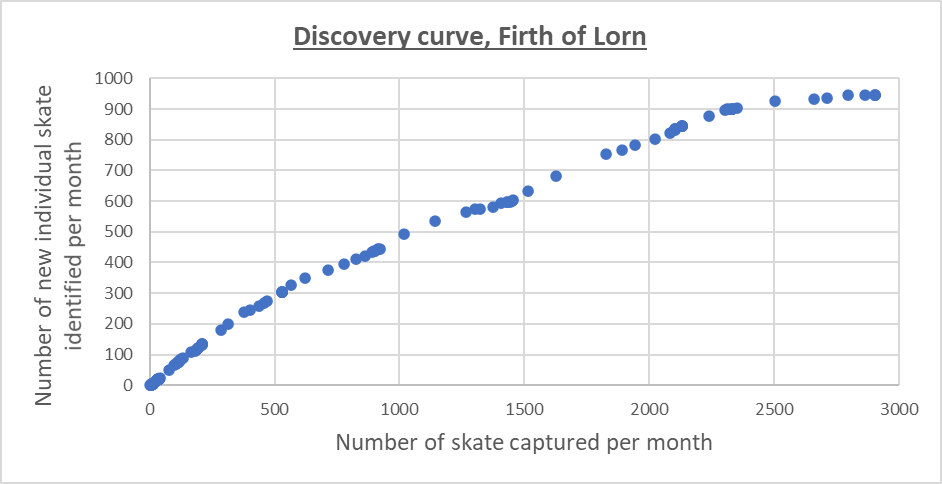
Figure 1. Discovery curve - the number of new skate captured per month as capture events increase in the Firth of Lorn.
Discovery curves can be used to estimate the number of skate within the population by looking at the number of skate captured against the number of new skate identified. As you can see (Figure 1), the line has begun to level off at around 950 as skate are recaptured more often than new skate are captured. This suggests the number of skate that have been present in the Firth of Lorn since 1998 is around 950. We expect that catches of new fish will still occur as transient skate will move around and be caught in the Firth of Lorn and young skate will join the population.
Sound of Jura
The number of skate reported from the Sound of Jura has risen by 226%, from 191 to 624, since the last summary report in 2018. Of the 624 individual skate, 422 are female (67%) and 202 are male (32%), which is a slightly higher number of females to males than in the Firth of Lorn (Table 1). There are 169 skate that have been recaptured at least once (27%), and 12 skate that have been recaptured 5 or more times (2%). Of those skate recaptured at least once, 131 were females (78%), and 38 were males (22%).
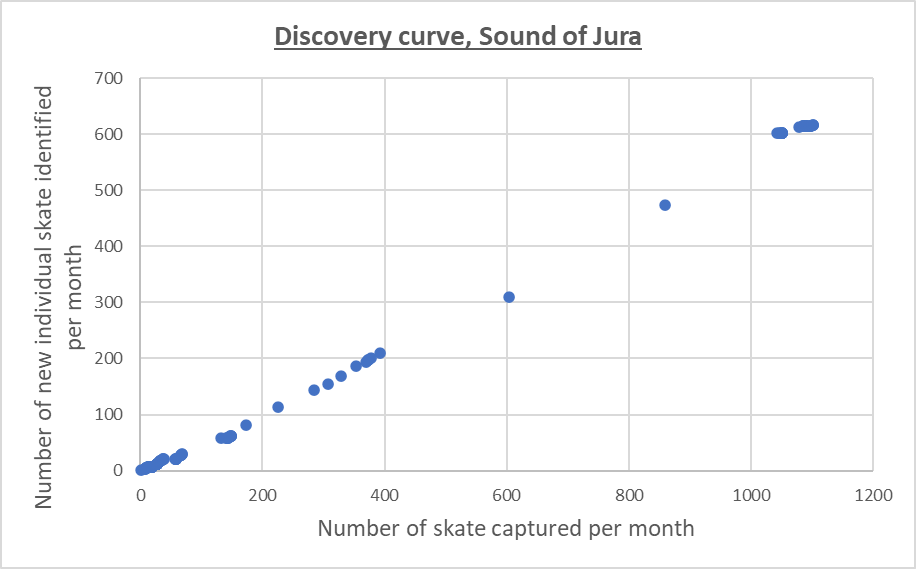
Figure 2. Discovery curve - the number of new skate captured per month as capture events increase in the Sound of Jura.
The discovery curve for the Sound of Jura (Figure 2) may have begun to level off at just over 600 skate or maybe not, time and more data will hopefully clarify the number of skate in the area.
Orkney, Shetland and the Outer Hebrides
Skate observations from Orkney, Shetland and the Outer Hebrides have been included in this report for the first time. The number of individual skate reported across these regions wais 145, of which 86 were females (61%) and 54 were males (38%). Only 1 skate caught in these regions whas been recaptured – Di001623. Di001623 is a male skate weighing approximately 41kg (91lb) that was first caught and tagged by the Orkney Skate Trust at Billia Croo in June 2019, and then spotted on a baited camera deployed by the Orkney Skate Trust at Neban Point, approximately 6 kms away, 3 months later in September 2019 (Figure 3).
Di001623 isn’t the only skate in the database that has been spotted on a baited camera. The Scottish Association for Marine Science did some baited camera work for skate in the Loch Sunart to the Sound of Jura MPA in 2017 and 2018. Six out of the 9 photos of skate captured were matched to skate in Skatespotter (Di000385, Di000414, Di000469, Di000514, Di000522, Di000685).
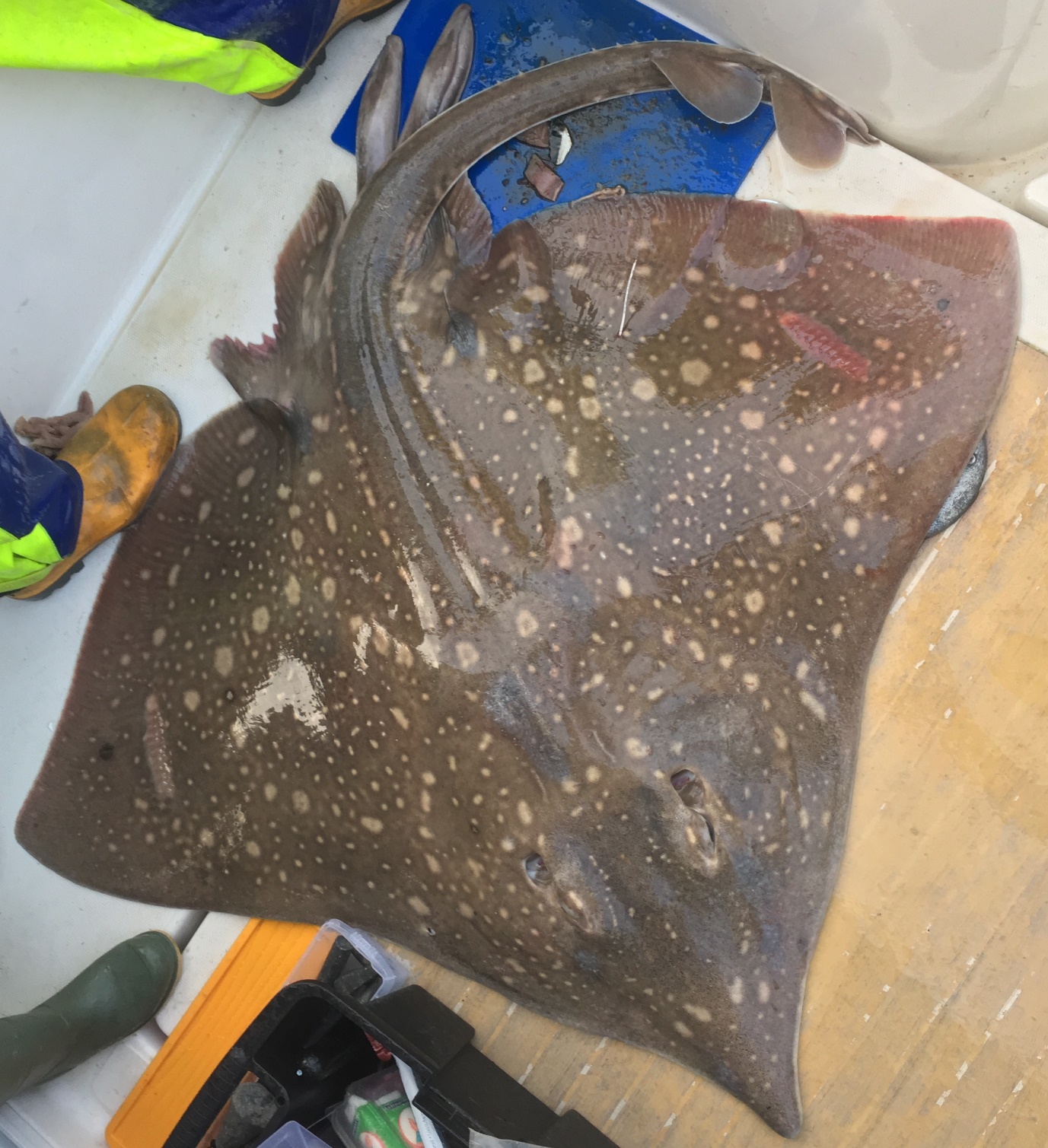
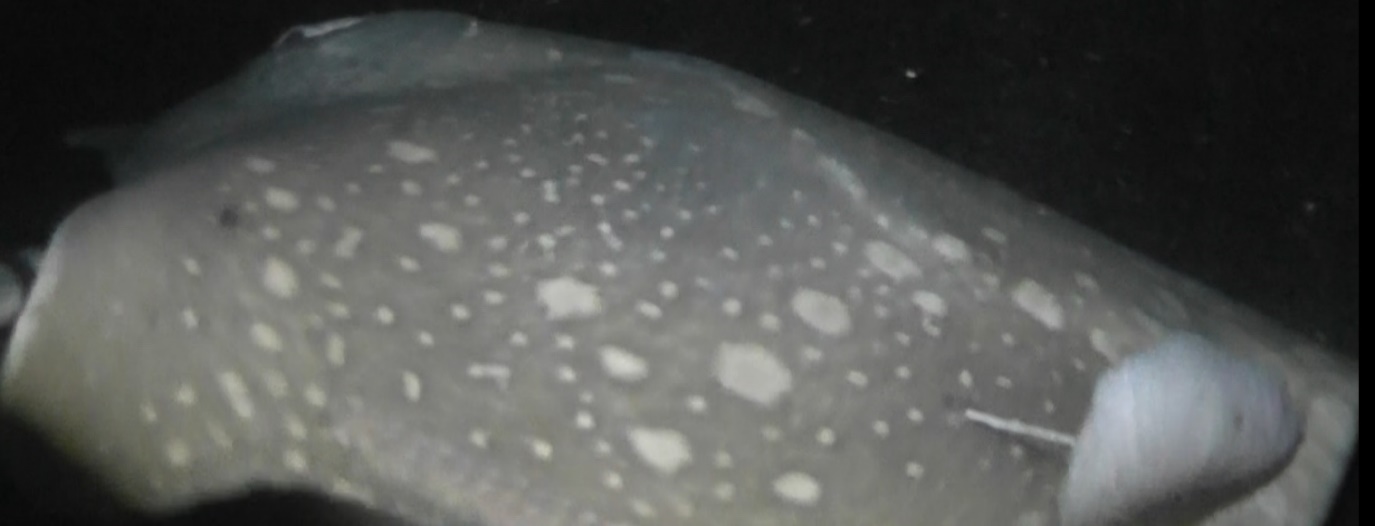
Figure 3. Male skate Di001623 which was tagged at Billia Croo in Orkney in June 2019 by Orkney Skate Trust and then spotted at a baited camera at Neban point in September 2019, the tag is visible in the photo.
Recaptures
As stated previously, 40% of the skate in the Loch Sunart to the Sound of Jura MPA (631 skate out of 1580) have been recaptured at least once. This suggests that nearly half of all the skate in the MPA use the area for extended time periods. This is likely due to a combination of residency and site fidelity (where the skate return to the same area regularly). The histogram in Figure 4 shows that a few skate have been recaptured much more often than the majority. Skate Di000289, which is male, has been recaptured the most at 22 times in the Firth of Lorn. Di000289 was first caught in September 2016 and has been caught every year since, including most recently in June 2021. In the previous report, the most recaptured fish was the female Di000122, also from the Firth of Lorn, which had been caught 14 times. She was last caught in August 2019, making it 16 recaptures. Di000031 is now the most recaptured female having been caught 20 times, also in the Firth of Lorn and weighing 63kg (139lb) when last reported. She was first caught in April 2014 and has been captured nearly every year since (except 2015), most recently in July 2021. While most recaptures of skate have taken place in the Firth of Lorn due to a higher fishing effort and greater amount of data returned from this area, skate have also been recaptured in the Sound of Jura, with a female skate, Di000569, being re-caught 9 times. She was first caught in April 2017 and most recently reported caught in March 2019.
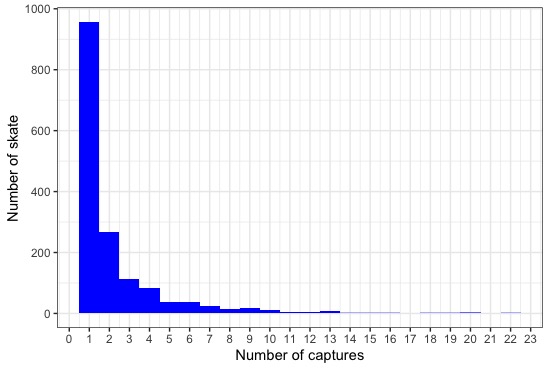
Figure 4. A histogram showing the frequency of recaptures of individual skate from the Firth of Lorn and the Sound of Jura e.g. over 900 skate have been recaptured once, and over 250 have been caught twice.
Damaged Skate
Occasionally skate can be damaged; we think that this is as a result of natural predation, natural interactions with other skate, being caught by mobile fishing gear vessels as bycatch (meaning they were not being targeted by the fishery and were not intentionally caught), or due to poor handling and release during angling (please see the Skate Handling guide – https://skatespotter.sams.ac.uk/guides/handling.php - for advice on how to maintain skate in the best condition). Approximately 70 skate (4.4%) have been reported as having signs of anthropogenic damage, scars or wounds, of which 23 skate (1.4%) have damaged or missing tails (Figure 5).
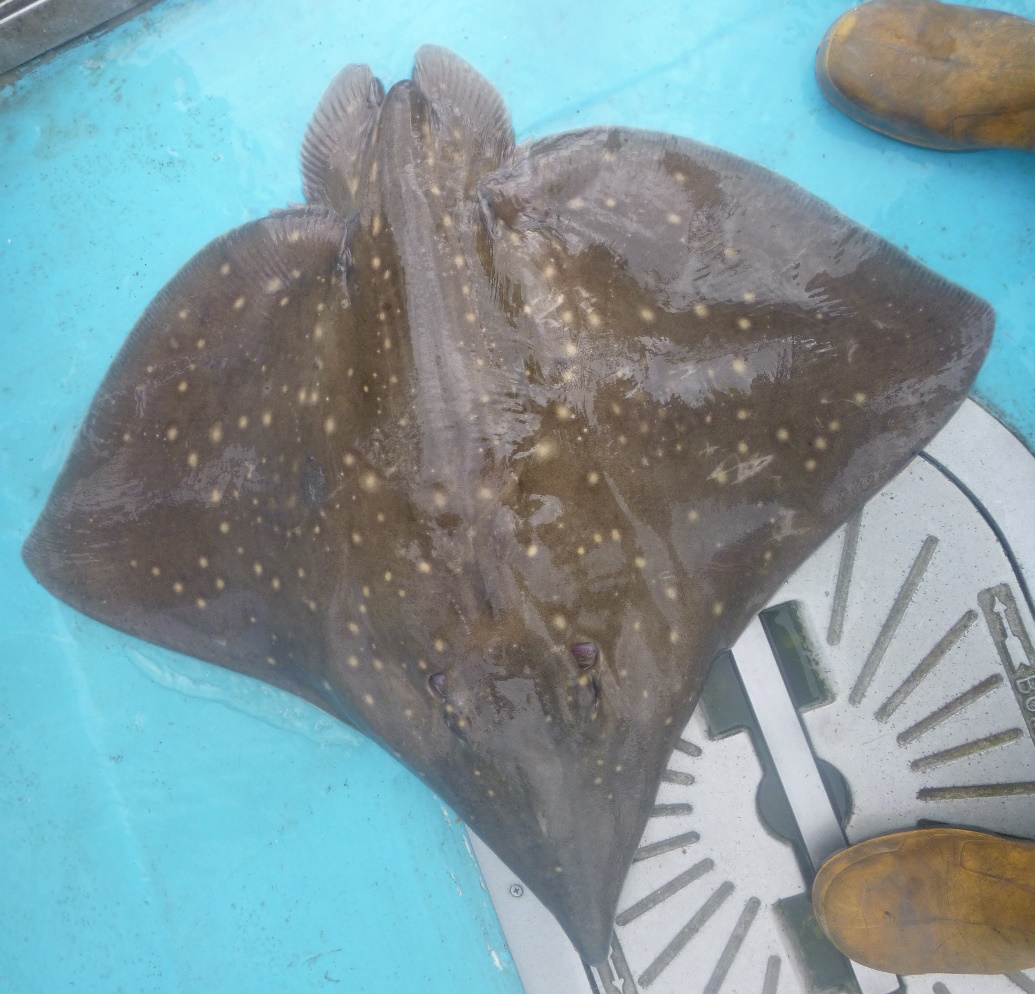
Figure 5. Skate Di000279 which has lost its tail.
In 2019 we received a number of reports of skate with mouth damage (Figure 6) in the Sound of Jura and the Firth of Lorn but we were unable to unequivocally attribute the damage to any specific activity. We are grateful to the anglers who provided the images to help us investigate this. Long term information is essential to investigate this kind of issue. The damage has not been observed since 2019, but we would like to hear from anyone who spots anything similar in the future.
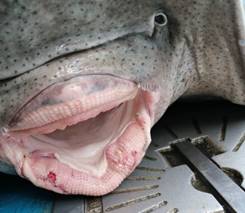
Figure 6. Skate mouth damage reported in 2019
A number of skate are captured with ropes on their tails in the MPA every year. We think this is due to commercial fishermen using the rope to return bycaught skate, but not removing the rope before doing so. Mobile gear fishing is banned within most of the Loch Sunart to the Sound of Jura MPA, but these skate may have been captured and returned outside the boundary or in areas of the site where fishing is allowed. We are grateful to anglers for reporting the numbers of skate captured with ropes on their tails to us because this gave us evidence with which to approach the commercial fishing associations. We have been able to encourage best practice for returning skate using the images provided and we have provided lifting tarps to commercial fishermen to help them return skate more safely.
Big skate!
Some very large skate continue to be caught, and their photos submitted to Skatespotter. Skate are no longer weighed, rather weight is estimated using weight tables from length and wingspan. The largest skate currently recorded in Skatespotter is skate Di000206 (Figure 7), a female which has been consistently recorded at around 100 kg (222 lb). There are potentially some heavier skate in the database, however their weight records are more varied over time – just a reminder here to measure your skate carefully! Currently, there are approximately 70 female skate in Skatespotter that weigh over 90.7kg (200 lb) this is approximately the same weight as a baby elephant! The three largest males currently in Skatespotter all weigh around 66 kg (145 lb) - Di001038, Di001539 and Di001548. Female skate are known to grow much larger than male skate, which is a common phenomenon seen across many fish species. It is generally accepted that females require a larger body size to produce young.
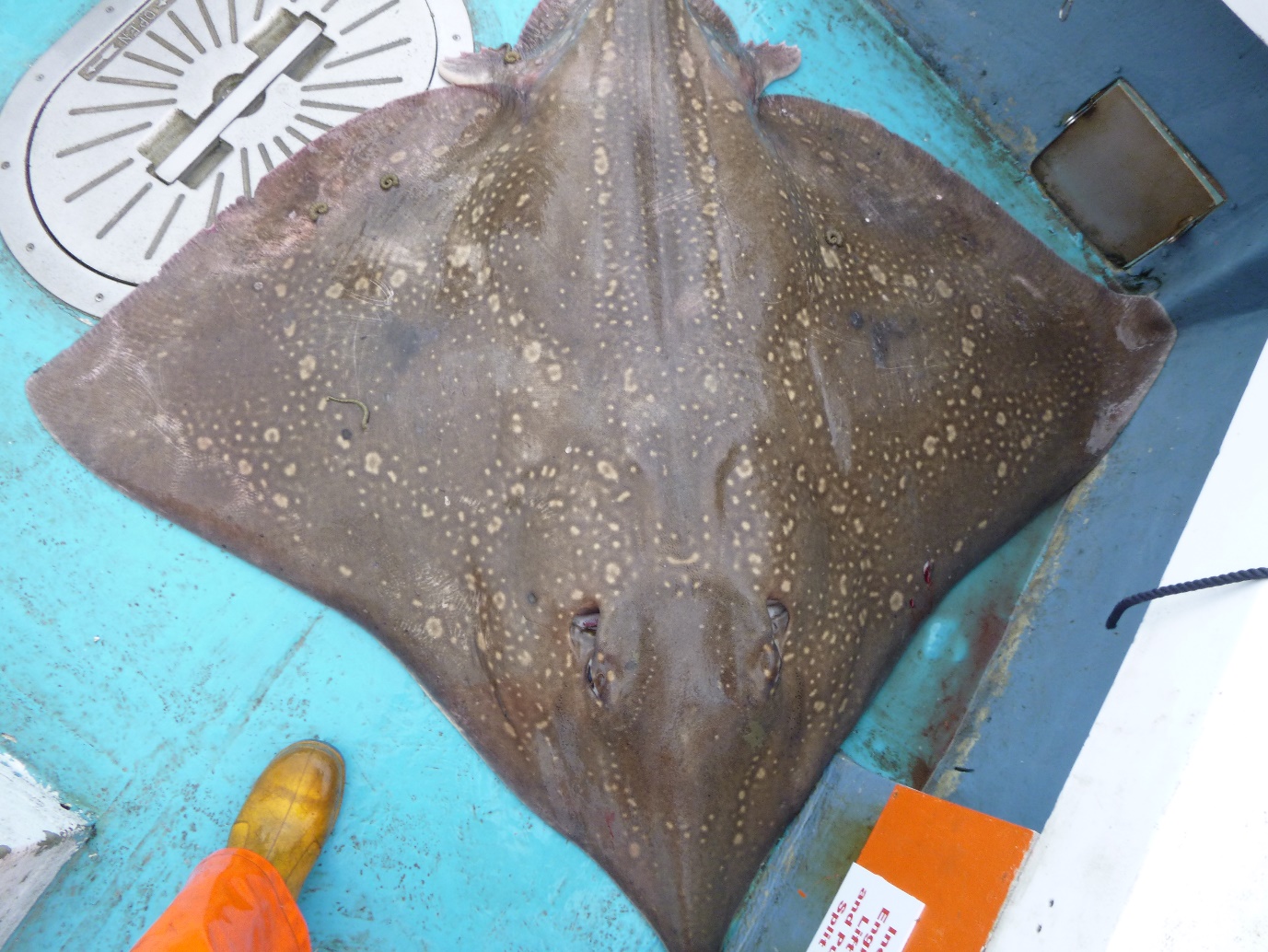
Figure 7. Photo of female skate Di000206 which is the largest skate in the database at around 222 lb (100 kg).
Skate movements
We have divided the coast up into regions in Skatespotter in order to report more generally where skate are captured and check on their movements (Figure 8). The Loch Sunart to the Sound of Jura MPA is divided into Loch Sunart, the Sound of Mull, the Firth of Lorn and the Sound of Jura.
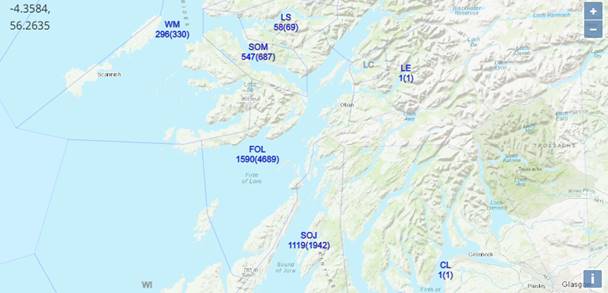
Figure 8. The Argyll coast is divided into Regions in Skatespotter to describe the general area where skate are captured.
Out of all 1,600+ skate caught in the MPA in Skatespotter, only 11 have been recorded as moving between regions. This could be because most of the data in Skatespotter originates from the Firth of Lorn. However the number of repeat captures of skate in the same region and even on the same fishing mark suggests a high level of residency of skate in a small area. This has also been shown in our more detailed acoustic tagging work (Lavender et al 2021). Of the exceptions, for example, the female skate Di000424 was first caught in the Firth of Lorn in September 2017 and then in the Sound of Jura approximately 42km away in May 2018 (Figure 10). Skate Di000167, also female, was caught three times in the Firth of Lorn between April 2016 and August 2017 and most recently caught in the Sound of Mull approximately 19km away in August 2019 (Figure 9).
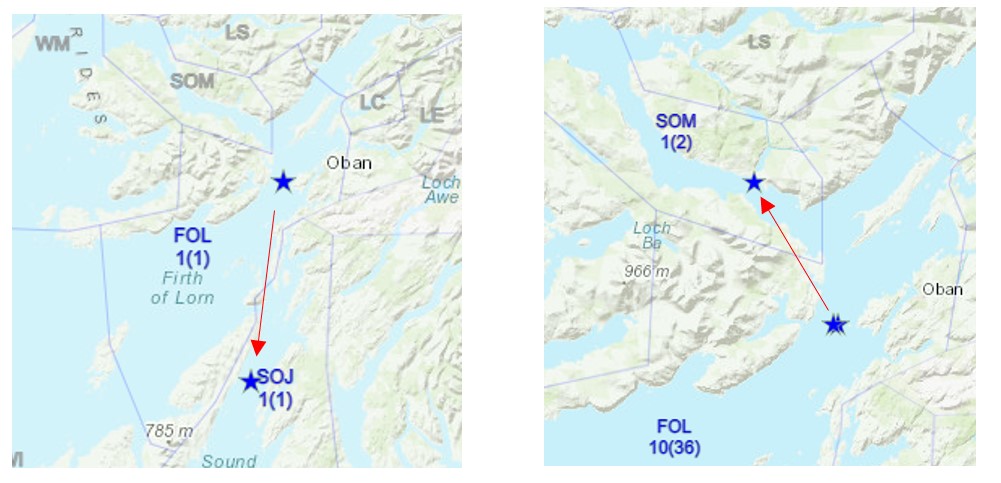
Figure 9. Movements of skate Di000424 (left) between the Firth of Lorn (FOL) and Sound of Jura (SOJ) and of skate DI000167 (right) between the Firth of Lorn (FOL) and the Sound of Mull (SOM).
Skate image gallery
We are continually working on the catalogue and hope to update it every 3 months or so. Please check back often to see if your photo has been added.




